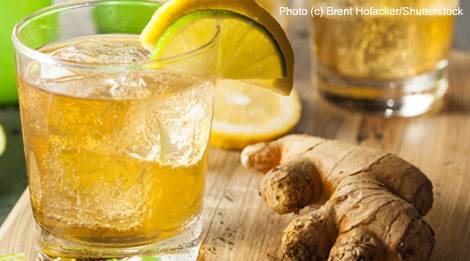|

How to Make Your Own Ginger Beer
Natural carbonated beverages made at home, using fermentation, are fun, delicious, and healthy.
By Michelle Branco
Eating a diet of whole foods that are both delicious and unprocessed has been an important goal for our family as our children grow up. Like many families, it is a work in progress and we are learning all the time.
Some of the changes have been easy – fresh seasonal produce actually does taste better, after all. Some of the changes have been harder. For example, I have been unable to unlearn my love of soft drinks. There’s something about the sweet fizzy rush that I just can’t seem to kick. Sparkling water with some lemon or even some fruit juice is a fair substitute, but there’s something about the sweet fizz that just isn’t captured in a spritzer.
After trying a natural ginger beer one day, I decided to see if I might make a batch at home without any refined sugar at all. Memories of the exploding beer bottle in a childhood friend’s garage gave me some pause, though – so I worked up my courage with some research about how one might go about carbonating beverages using home fermentation.
There are several approaches to fermenting ginger in order to carbonate the beer. The traditional approach is to use the Ginger Beer Plant, which is, in fact, not a plant but a SCOBY: an organism that symbiotically combines bacteria and yeast. The same type of organism is used to cause fermentation in drinks such as the dairy-based kefir and tea-based kombucha. While there are a small number of producers who sell the Ginger Beer Plant, the supply is small.
Water-based kefir drinks are also another option that some home brewers have had success with. Water kefir grains are similar to dairy kefir grains, but are not interchangeable. Their appearance is quite different, with a firmness and translucency that reminds me of chopped well-cooked cauliflower.
Several online sources directed me to a whey-based fermentation process for water-based drinks. Since this was readily available, I ran a couple of experimental batches using different proportions of whey. Unfortunately, I wasn’t able to get any consistent results and the quality was poor. It would seem that it is possible, but prepare for some failures.
While the health benefits associated with the beneficial bacteria in the live cultures such as kefir are worth seeking out, procuring and caring for them poses a barrier that can be hard to overcome when you’re not entirely sure how much you’d like to invest in the process.
The results from commercial yeast, which most cooks have in their kitchen already, are fairly reliable and can be an encouraging nudge to try different methods down the road. The reliability of the yeast also allows experimentation with honey as the sweetener rather than more processed sugars.
Remember that the yeasts need sugar to survive and that honey’s anti-bacterial properties inhibit their growth somewhat. Thus, the drink will be sweeter at the beginning of fermentation than at the end – you may need to add additional sweetener at the end, in fact.
There is always some alcohol produced in any anaerobic fermentation process – even in bread making. While the exact alcohol content will vary, the levels for these types of recipes are far lower than in traditional beer or wine making. They are typically well under 0.5%, which is considered non-alcoholic.
Homemade ginger beer is nothing like the ginger ales commercially available. The carbonation is subtler; it’s quite a lot livelier and can have a strong bite to it. Over ice, that makes for a refreshing drink, but you may find that cutting with carbonated water makes it more palatable for kids who are looking for that familiar sweet fizz.
Ginger Beer Recipe with Yeast
1 big piece ginger root, more or less peeled, cut into small pieces (about 1/2 cup of pieces)
6 cups water, preferably spring water (without chlorine)
2/3 cup honey
1/2 tsp cream of tartar
2 tbsp lemon juice (optional)
1/2 tsp commercial yeast
Place ginger root pieces and 1 cup of water in blender. Blend on high until you have a purée (adding more water as necessary to keep it moving).
Bring remaining water to a boil and add honey, stirring until dissolved. Add in ginger and stir until blended. Remove from heat. Stir in cream of tartar and lemon juice if using.
Let cool until lukewarm warm. Strain through a fine strainer and pour into a 2L plastic pop bottle. (I actually used water bottles 700ml and 1.5L each). Add yeast and swirl until dissolved – adding additional water if needed, leaving a couple inches of head space.
Cap bottle(s) and place in a quiet corner – avoid shaking them and keep them away from curious hands. The plastic bottles will start to firm up after about 24 to 36 hours – when they are hard, it means the carbonation is complete. Keep testing them and don’t forget about them.
The sediment at the bottom of the bottle is safe to drink, but not appetizing. Decant the ginger beer carefully and slowly to minimize the cloudiness. Place in the fridge until well chilled – and enjoy!
Michelle Branco is a freelance writer and blogger. She blogs about mothering, breastfeeding, product safety and, of course, food. Her much-put-upon family serves as lab assistants, taste testers, and clean-up crew. She is also an International Board Certified Lactation Consultant and when she’s not at the keyboard or experimenting in the kitchen, she runs a private lactation consultancy practice.
|

